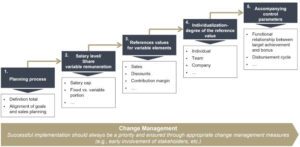Inadequate incentive systems cause dissatisfaction in the sales force
Sales organizations and their employees are often dissatisfied with their incentive system. This is because the corporate objectives and the incentive system are usually not sufficiently aligned, which leads to friction. The system also often does not differentiate optimally according to the performance of individual employees. As a result, top performers are penalized. Furthermore, the payout can rarely be influenced by the individual employee, which also undermines the basis for motivation. Ultimately, manufacturers also often fail to anchor the topic of service and software sales substantially in compensation.
Optimizing the incentive system is one solution – but there are many challenges along the way.
Typical challenges in optimizing the sales incentive system
- Goals of the company and the incentive system are often not synchronized – Therefore, critical goal conflicts occur!
- The mix between individual and collective goals must be well chosen. On the one hand, employees need to see their performance mapped, on the other hand, the promotion of team play is essential in many companies!
- The incentive system is usually too focused on sales – Price and/or profitability elements are missing
- Target fulfillment in some areas compensate for deficits in others. Especially the (lack of) sales of services and software is often compensated with hardware!
How to: Solution approaches for a successful incentive system
Corporate goals versus incentive system
Corporate goals and the goals of the incentive system must be synchronized! If the incentive model is calibrated to maximize sales and the company tries to optimize its profitability, this will result in misaligned incentives and misallocations.
In price negotiations, for example, the sales department tends to focus more on protecting revenue than on increasing profitability (possibly at the expense of revenue). Here, an adjustment of the system is necessary, for example by introducing a price and/or profitability element.
The variable portion
Classically, many incentive systems have a variable component. When adjusting the variable component, care must be taken to ensure that it varies significantly between countries, industries and organizational cultures. What provides the basis for motivation in one situation can have very negative effects in another. The advantages and disadvantages of a change with regard to this sensitive issue must be decisively analyzed in advance.
Individual versus collective goals
Traditionally, many targets were agreed and remunerated at the individual level (for example, sales per employee). In several industries, however, there is a tendency to migrate more strongly to collective targets (for example, team targets). This is particularly relevant when team play is absolutely essential (for example, when large sales teams are responsible for key accounts) and individual accountability of results is no longer possible.
However, many companies have to realize that the (old individual) incentive system was substantially used to control sales. Now new tools and approaches have to be created to control sales systematically and sustainably!
Incentive to sell (digital) services and software
Many traditional manufacturers want to boost sales of (digital) services and software. On the incentive side, however, a lack of success in software and service, for example, is still often compensated for by the sale of classic hardware.
Solutions include models that increase the total payout if software targets are met (software boost). Alternatives include minimum software and service targets, below which the total incentive is reduced.
The optimal implementation
The design of a new sales incentive system is an essential step to strengthen the sales force. Before any implementation, it is necessary to simulate the impact of the system to understand what effect the system will have. Fine-tuning the system can be done transparently and comprehensively on this basis. This information base is especially necessary to convince the sales force of the new system.
In addition, (automated) tools must be created with which the sales department can obtain information regarding its performance (for example, at the monthly level) and its potential payout. In this way, the administrative effort can be kept within limits and the sales department can take care of selling.
Level system for the content development of a compensation system for the sales department

Selected R&P project examples
- Complete redesign of an international sales incentive system for 200+ employees. The successful project included the definition of the incentive elements, the detailing of the rules and the support of the roll-out up to the monthly controlling on an employee basis.
- Optimization of the bonus system for 600+ employees of a large sales organization. Here, the sales force was questioned in detail (online survey, expert interviews) regarding their preferences and current problems in the incentive system.
Optimizing the incentive system for your sales force
Do you want to optimize the incentive system for your sales force? Do not hesitate to contact us. We have already successfully accompanied many companies in this complex and demanding challenge.

Michael Fechner
Michael Fechner is Partner at Prof. Roll & Pastuch – Management Consultants. For more than 17 years he consults international corporations and medium-sized companies world-wide. Before joining Roll & Pastuch, he worked as a project manager at Simon-Kucher & Partners and spent several years in London. His focus is on price management, sales and strategy. To support companies in these areas Mr. Fechner publishes articles, conducts seminars and speaks at various events.

Steffen Kampmann
Steffen Kampmann is a partner at Prof. Roll & Pastuch – Management Consultants and heads the Chemicals, Plastics and Raw Materials divisions. He has been working as a consultant in the international environment for multinational corporations and medium-sized companies for more than 13 years. Mr. Kampmann brings extensive experience from a variety of strategy, pricing and sales projects. He also publishes professional articles and regularly appears as a moderator and speaker on the topics of strategy, pricing and sales.